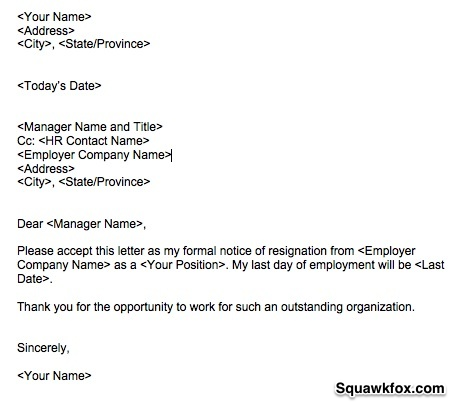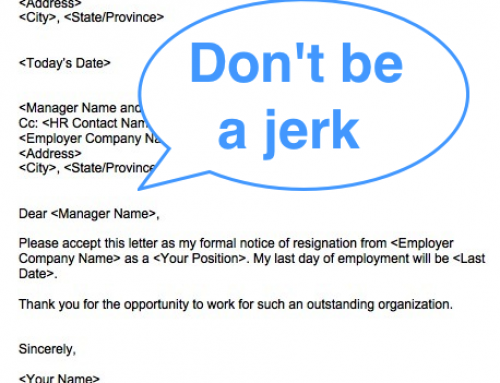Use my resignation letter example to resign from your job easily. There’s also a resignation email message example if you’re remote, work from home (WFH), or just want to resign via email.
Whether you’re resigning from a great job for an even greater opportunity or you’re quitting a career that sucks, leaving your position using a professional resignation letter can keep the door open for future jobs.
Your future employer and colleagues may come from your past, so always leave your current position with style and grace.
People change jobs, companies fold, freelance gigs pop up, and entrepreneurs build new and fresh organizations, so stay on good terms with people (even if you don’t like them) so future opportunities are possible.

Image: Resignation Letter or Resignation Email
Besides, with social media sites like LinkedIn, Twitter, Instagram, and Facebook it’s far too easy for a slighted employer or colleague to amplify your negative parting words. So don’t let a bad post become the sign post for your career.
Resignation Letter Example (three sentences)
[Your Name]
[Address/Email Address]
[Today’s Date]
[Manager Name and Title]
Cc: [HR Contact Name]
[Employer Company Name]
[Address]
Dear Mr./Ms.Lastname,
Please accept this letter as my formal notice of resignation from [Employer Company Name] as a [Your Position]. My last day of employment will be [Last Date].
Thank you for all the opportunities this company has provided me.
Sincerely,
[Your Name]
No swearing and no “I told you so’s” either. Three sentences. Done. Done. And more done. All the done and none of the drama.
Resignation Letter Example (download)
Prefer a downloadable resignation letter example document so Human Resources can print and rubber stamp it in triplicate? I’ve got you covered. The rubber stamp in triplicate is up to your old boss. Smile.

What to Include in a Resignation Letter
This letter of resignation example is short and sweet at only three sentences, and that’s how you win the resignation game. Here’s why in three easy steps, plus a bonus:
- 1. Say you’re leaving. Be brief. Your resignation letter is neither a confessional nor an explanation, so don’t feel you need to voice parting words. And don’t go into details! To get the job done, just say, “Please accept this letter as my formal notice of resignation from [Employer Company Name] as a [Your Position].” One sentence and done.
- 2. Give Notice. You may want to get outta there fast, but it’s better to give the required or standard duration which is often two weeks notice. A little notice can help maintain a good relationship with your former employer. Just be clear of your ending date, for example: “My last day of employment will be [Last Date].”
- 3. Express gratitude. Kill them with kindness by giving thanks, even if you don’t truly mean it. And if you do mean it, more power to ya! For example: “Thank you for all the opportunities this company has provided me.”
- 4. Need a transition? Bonus sentence: If your job requires a transition, go ahead and add: “Let me know if there is anything I can do to make this transition easier. You can contact me at YourName@email.com or [phone number].” Leaving an invitation to be of assistance during or after a transition is nice, but not always necessary. This fourth sentence is up to you.
Resignation Email Message Example and Writing Tips
Pandemic-era and WFH situations make it possible these days to just quit it by hitting send. If you’re into signing off via email, here’s your resignation email message example. Copy, paste, and proofread your way into a new career. Easy.
Resignation Email Message Example
Email Subject Line: [Your Name] Resignation
Dear Mr./Ms. Lastname,
Please accept this letter as my formal notice of resignation from [Employer Company Name] as a [Your Position]. My last day will be [Date].
Thank you for all the opportunities this company has provided me.
Sincerely,
[Your Name]
I’m a fan of keeping email resignations short and sweet because it’s too easy to forward messages into an eternity or into a career oblivion. Keep your email drama-free — the less you say, the less likely ANYTHING will come back to haunt you. Kudos for not getting haunted by a bad email resignation.
Here are 6 writing tips for resigning via email:
- 1. Write a clear subject line. It may feel cold and terse, but a clear and concise resignation email subject line removes all doubt and is unlikely to get missed or buried in a stack of unread messages. Hit them with the news at the outset.
- 2. Say you’re resigning. Be concise. Your resignation email message is neither a confessional nor an explanation — you don’t need to go into details and always keep it drama-free.
- 3. Give Notice. Giving the required notice (often two weeks notice) can help maintain a good relationship with your former employer. No one wants to be stuck with a pile of work, so specify a specific date.
- 4. Express gratitude. Be kind and grateful, even if you don’t mean it. This is hard for many, but worth it. Promise.
- 5. Offer a transition period? If your job requires a transition, go ahead and add: “Let me know if there is anything I can do to make this transition easier. You can contact me at Your Name@email.com or [phone number].” Personally, unless you have a job in a specialized sector, feel free to skip this step. You’re not getting paid to hold the next employee’s hand after your leave.
- 6. Proofread the email. Signing off with a spelling or some other mistake can be embarrassing, so be sure to edit your resignation email message before hitting send! Keep your tone even and neutral.
Bottom Line: Your resignation email message should be drama-free (don’t go into details), use a clear email subject line, state your last day of work, give two weeks notice, and optionally offer a transition contact (your cell or personal email).
Love love love,
Kerry
Dig Deeper with more career resources:





this is a big help, but what if we have decided to leave for negative reasons in the company? What do I do if i need to get things off my chest to my boss so that she knows exactly why I’m leaving?
How do I write a letter of resignation due to a college internship?
Thank you for your help!
I am in the same situation regarding Patrick’s questions on December 23rd 2013.
I have been employed with this company for 6 years.
if you want to get something off your chest, send an “intent of resignation letter”, means send an email to your boss explain why you hate your job and what do you want to make it better, you have the intention of resigning any ways, so its a win-win situation, if your boss replies with a positive response, then you got what you want, and if he reply in a negative way (happened to me), then at least you got it off your chest, and you can proceed with a resignation letter :).
time sensitive: how do i write a resignation letter where in i am breaching contract? Apparently there is a 4week notice policy where i work. I have never broke a policy before of any kind. But they wanted me to start next week and i said i needed to give notice.. they gave me a start date in 2 weeks! after the fact i discovered the policy today.
do i address this in my resignation letter or say nothing and let the chips fall as they may?
i thought i might say “regretably i am unable to give 4 weeks notice.” ???
This was so helpful. The template was perfect. I had no idea how to phrase “I am leaving a decent(ish) dead end job at a nice place with mostly good people after 10 years because being unemployed is a much less depressing/scary prospect than waking up and going to work. Also, a 3 1/2 – 4 hour daily commute with no hope of being able to move closer is just not something I can handle doing any more.” Those details are better said in person, if at all. Thanks!
To think I was stressing over this resignation letter business. I found this very helpful.
Just wish I could write the letter then post it and run. Don’t like facing people in these situations arggghh. I’m resigning today
I just started my job a week ago and there is already a lot of issues with my job. But the main one is that I live 45 mins. away from my job and I dont have a car, my sister drives me. All my hours have been late and she cant come get me so late. So should I just do it quick or try to wait?
Thanks for this brief but helpful post. For Patrick, Suzanne and anyone else in a similar situation: don’t leave a paper trail. If you need to vent, ask for a meeting and do it face to face. If your employer refuses, let it go and move on with your life. The potential blowback for an angry screed isn’t worth the temporary benefit of telling off your boss.
How do u write a Resignation letter When u want to Leave Immediately. Do to unfairly treatment/Harassment when u Have Been dealing with it for so long without it looking not so Good??
I just started a sales associate position a week and a half ago, and there’s already so many red flags. Everyone talks bad about everyone, and I learned that in this small company, of 10-15 employees, 30 employees have been hired on and resigned over the course of 2015. Thankfully, I received a job offer with a great company and they want me to start immediately. Is it terrible if I give my manager an immediate resignation letter?
Short, simple, and to the point. Thank you.
I was laid off from my job as a web designer 4 weeks ago. My employer hasn’t given a return date at all, but he calls or emails me every other day with questions about work and has even gone as far as asking me to work on some projects. Without pay of course. Recently, I have gotten some pretty nasty comments from my employer because the company found out I picked up some freelance design work. Even though I have never signed a no compete clause. They feel I have gone against them with their competitor. Is there any legal stand on their part of I was to give them a letter of resignation. I have never taken a dime of unemployment either.
Hi,
How to write a resignation letter without sounding like you are not willing to leave? I am have a better offer from the other company.
James:
It is impossible to write a resignation letter that sounds as if you do not want to leave. There’s an old saying, “You can’t have your cake and eat it too.”
Leave or stay. Make a decision.
Allenso
This is very helpful….Thank You!!
Thanks for this, It was short, sweet, and to the point.
Thank you for this! I will be using it to quit a job that I wasted about half my life at.
I’m leaving one teaching job for another. My official new hire date is August 23rd. When do I give my letter of resignation?
Hi Lisa,
Does your contract require notice? It’s best to check your teaching contract to see how much notice your soon-to-be former employer requires. 🙂 It’s standard to give two weeks notice in many jobs, but I’m unsure about the details of your work. Good luck and congrats on the new job. kerry